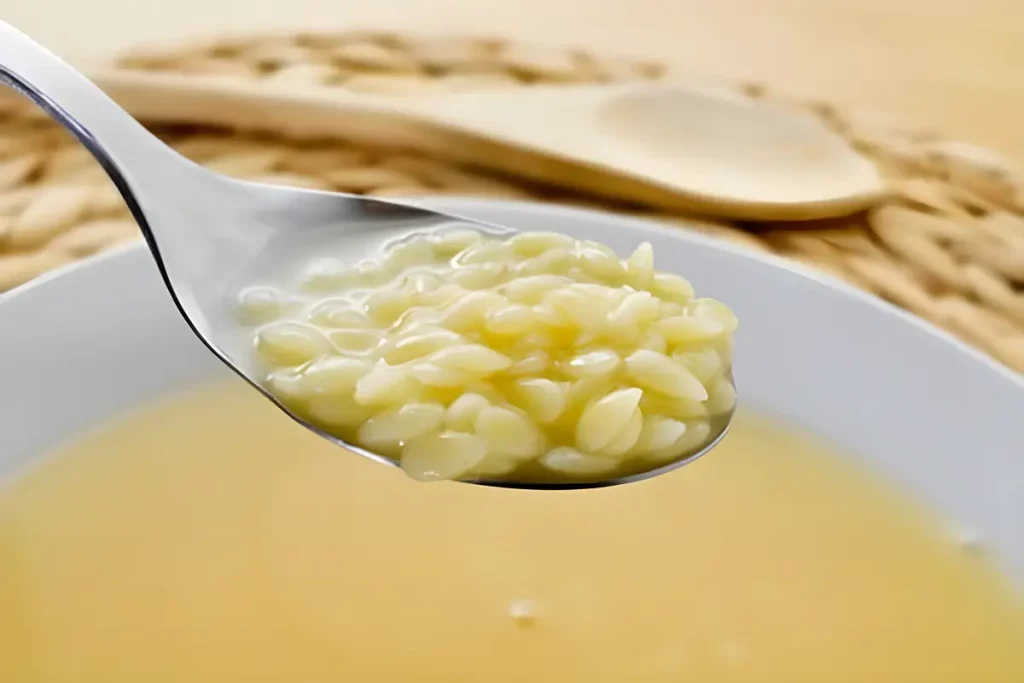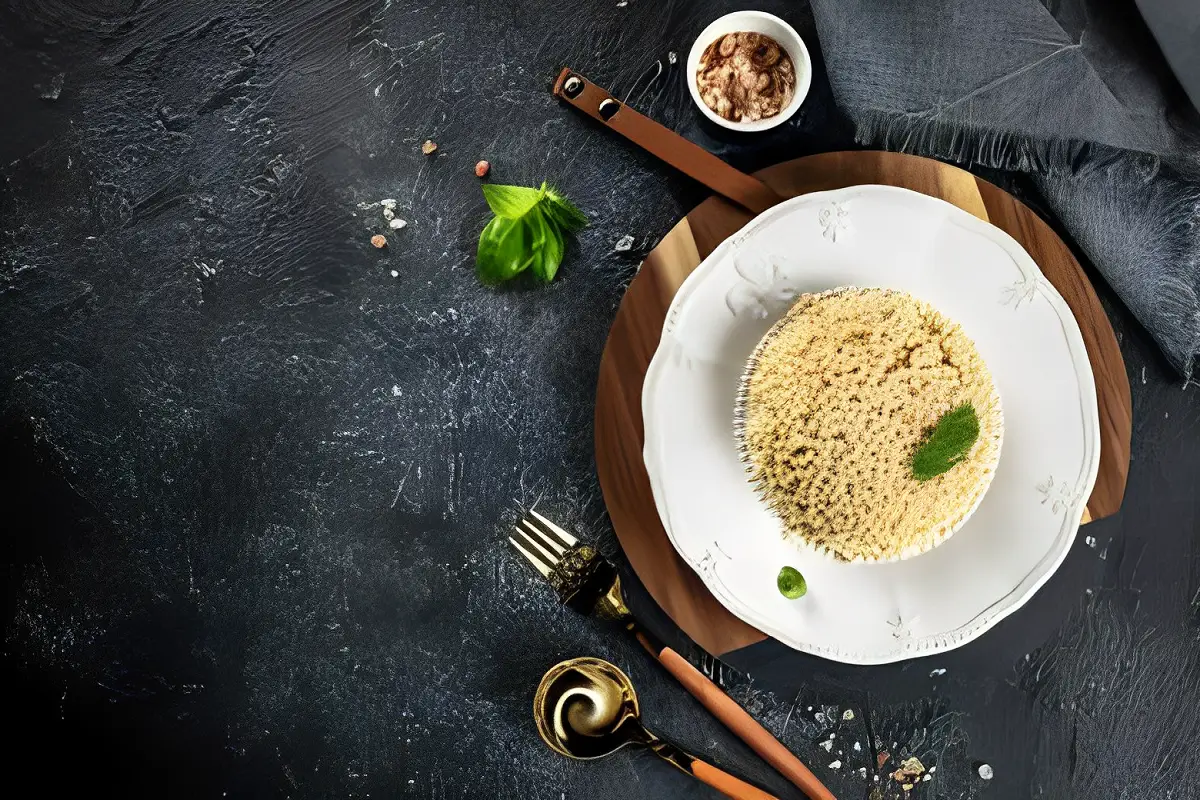Introduction to Pastina
What is Pastina?
Pastina, a term that literally translates to “little pasta,” is a culinary gem nestled in the heart of Italian cuisine. This tiny, star-shaped pasta has been a staple in Italian kitchens for generations, often hailed as the first solid food Italian babies are introduced to. But don’t let its diminutive size fool you; it’s packs a comforting punch and is versatile enough for any age.
The Cultural Significance of Pastina in Italian Cuisine
In Italy, this dish is not just food; it’s a cultural icon, evoking nostalgia and warmth. It’s the embodiment of home cooking, often prepared with a simple yet hearty combination of butter and milk. This dish transcends mere sustenance, offering a comforting embrace in a bowl. It’s a culinary tradition passed down through generations, each family adding their unique twist to this beloved classic.
The tiny pasta with a big presence, holds a special place in the heart of Italian cuisine. Its cultural significance goes beyond its role as a mere ingredient; it embodies traditions, family, and the essence of Italian culinary heritage.
Selecting Ingredients for the Perfect Dish
When crafting the perfect bowl of little pasta, the choice of ingredients is paramount. Opt for high-quality, small-shaped pasta to ensure the best results. The magic lies in the simplicity of the ingredients – a dollop of rich, creamy butter, and a splash of milk, preferably whole for its creaminess. These elements come together to create a dish that’s both unpretentious and deeply satisfying.
Types and Varieties
Pastina, in its essence, is a celebration of variety and versatility. This section will guide you through the different types and shapes of little pasta available, each bringing its unique texture and charm to the table.
Different Shapes and Sizes
Pastina comes in an array of delightful shapes and sizes, each with its own personality. From the classic stelline (little stars) to acini di pepe (peppercorns), and alfabeti (alphabet shapes), the variety is astounding. Each shape offers a different mouthfeel and aesthetic, making it a versatile choice for a range of dishes.
Popular Brands and Regional Varieties
While little pasta is a staple in Italian households, its popularity has crossed borders, leading to a variety of brands offering this tiny pasta. Brands like Barilla and Ronzoni have been long-time favorites in many kitchens. Regional varieties also add a unique twist to pastina, with each area in Italy boasting its own version of this classic pasta.
The Art of Cooking
Mastering the art of cooking pastina is a journey into the heart of Italian culinary tradition. This section provides a step-by-step guide to preparing pastina, ensuring a perfect dish every time.
Step-by-Step Cooking Guide
Cooking pastina is a simple yet delicate process. Begin by bringing a pot of water to a boil. Add a pinch of salt for flavor. Then, pour in the pastina, stirring occasionally to prevent sticking. The key is to cook it until it’s just al dente, which usually takes about 5 minutes. Remember, this dish will continue to cook a bit even after you’ve drained it, so timing is crucial.
Tips for Perfect Consistency
Achieving the perfect consistency with pastina is all about balance. If you’re aiming for a soupier dish, reserve some of the cooking water to add back into the pasta. For a creamier texture, a splash of milk or a dollop of butter can work wonders. The goal is to create a dish that’s comforting and satisfying, with each tiny pasta perfectly coated in its creamy or brothy accompaniment.
Nutritional Value of little pasta
Delving into the nutritional aspects of pastina reveals why this tiny pasta is not just a comfort food but also a wholesome choice for various diets.
Health Benefits
Little pasta, primarily made from wheat, is a good source of carbohydrates, providing the energy needed for daily activities. It also contains a modest amount of protein, essential for muscle growth and repair. While pastina itself is low in fiber, pairing it with vegetables or a protein source can create a balanced meal.
Good Source of Carbohydrates
As a carbohydrate-rich food, pastina provides a quick source of energy. It’s an ideal option for athletes and individuals with active lifestyles who require easily digestible carbohydrates for fuel.
Dietary Considerations
For those mindful of their diet, it’s offers versatility. It’s naturally low in fat and can be adapted to fit into a healthy eating plan. However, for individuals with gluten sensitivities or celiac disease, traditional wheat-based pastina might not be suitable. Fortunately, gluten-free alternatives made from rice or corn flour are available, ensuring everyone can enjoy this comforting dish.
Creative Variations of Little pasta Recipes
Pastina’s simplicity is its strength, serving as a versatile base for countless creative culinary experiments. This section explores various ways to elevate the humble pastina into something extraordinary.
Making it Fun and Nutritious for Kids
For children, Little pasta can be both a delightful and nutritious meal. Enhance its appeal by adding colorful vegetables or making it part of a soup with chicken broth and tiny meatballs. The fun shapes of this dish, like stars or alphabets, are particularly appealing to kids, making mealtime both fun and healthy.
Vegetarian and Vegan Options
Pastina is a blank canvas for vegetarian and vegan diets. Cook it in vegetable broth and add sautéed vegetables like spinach, tomatoes, and mushrooms for a hearty meal. For a vegan twist, replace butter with olive oil and add plant-based protein sources like chickpeas or tofu to turn it into a complete meal.
Pairing Pastina with Other Dishes
Pastina’s subtle flavor makes it an excellent side dish, complementing a variety of main courses. Serve it alongside grilled fish or chicken, or mix it into a salad for added texture. It’s also perfect in casseroles, absorbing flavors from sauces and other ingredients.
Storing and Reheating Pastina
Proper storage and reheating are crucial for maintaining the quality and taste of pastina. This section provides practical tips to ensure your little pasta remains as delightful as when it was first cooked.
Best Practices for Freshness
After cooking, if you have leftover little pasta, it’s important to store it correctly to retain its texture and flavor. Cool the pastina completely before transferring it to an airtight container. Store it in the refrigerator, where it will stay fresh for up to 3 days. Remember, little pasta tends to absorb moisture, so keeping it sealed is key to preventing it from becoming too dry or sticky.
Reheating Without Losing Texture
When it comes to reheating, the goal is to restore the pastina’s warmth and texture without overcooking it. The best method is to reheat it gently on the stove. Add a splash of water or milk to the pan to loosen the pasta and prevent it from drying out. Heat it over low heat, stirring occasionally, until it’s warmed through. This method helps to revive the little pasta, making it almost as good as when it was freshly made.

Pastina in Different Cuisines
Pastina may have its roots in Italian cuisine, but its appeal stretches far beyond Italy’s borders. This section explores how different cultures have embraced and adapted pastina, infusing it with local flavors and ingredients.
Global Twists on the Classic Recipe
Around the world, chefs and home cooks alike have taken the basic concept of pastina and infused it with local culinary traditions. In some regions, pastina is cooked in rich, flavorful broths, absorbing the essence of spices and herbs. In others, it’s combined with local vegetables and proteins, creating unique dishes that reflect the diversity of global cuisine.
Fusion Dishes Featuring
The versatility of pasta makes it an ideal ingredient for fusion cuisine. Imagine pasta in an Asian-inspired soup, swimming in a miso or curry broth, or as part of a Mediterranean salad, mixed with olives, feta, and sun-dried tomatoes. These fusion dishes showcase pastina’s ability to blend seamlessly with a variety of flavors and textures.
Hosting a Pastina-Themed Dinner
For those who love to entertain, a pastina-themed dinner party could be a delightful way to explore this versatile pasta. Offer a range of dishes showcasing it in different cuisines – from a classic Italian pastina in brodo (in broth) to more exotic creations. It’s a celebration of how a simple ingredient can be transformed across different culinary landscapes.
Special Diets
Pastina’s adaptability extends to accommodating various dietary needs and preferences. This section focuses on how pastina can be modified to suit special diets, ensuring that everyone can enjoy this comforting dish.
Gluten-Free Alternatives
For those with gluten intolerance or celiac disease, traditional wheat-based pastina is off-limits. However, the growing demand for gluten-free options has led to the production of pastina made from alternative grains like rice, corn, or quinoa. These gluten-free versions allow individuals to enjoy it without compromising their health or dietary restrictions.
Low-Calorie Versions
It’s can also fit into a low-calorie diet. By controlling portion sizes and choosing light accompaniments, It’s can be part of a healthy meal. For instance, pairing pastina with a broth-based soup or a salad can create a fulfilling yet low-calorie dish. Additionally, using low-fat milk or cheese can help reduce the calorie count while still providing the comfort and taste of traditional dish.
Celebrity Chefs’ Takes on this dish
Celebrity chefs have also put their spin on pastina, creating dishes that are both innovative and mindful of dietary considerations. From using it in vegetarian or vegan recipes to incorporating it into low-carb diets, these chefs have shown the versatility of pastina in high-cuisine contexts. Their creations often inspire home cooks to experiment with pastina in new and exciting ways.
Popular Culture
Pastina’s influence extends beyond the kitchen, making its mark in popular culture. This section delves into how this humble pasta has been represented in movies, literature, and as a trend in the culinary world.
Movies and Literature
In film and literature, pastina often appears as a symbol of comfort, family, and tradition. It’s not uncommon to find scenes in Italian movies where a character finds solace in a bowl of pastina, or in books where pastina’s a reminder of childhood or familial love. These portrayals reinforce the idea of pastina as more than just food – it’s a vessel for memories and emotions.
It’s appearances in movies and literature highlight its unique position as more than just food. It’s a cultural symbol, a comfort blanket, and a thread that weaves together the past and present, making it a cherished part of popular culture.
The Dish’s Role in Food Trends
In the ever-evolving world of food trends, pastina has had its moments of fame. It’s been featured in gourmet magazines and food blogs, often highlighted for its simplicity and nostalgia factor. Chefs have reinvented pastina in upscale restaurants, presenting it in innovative ways that pay homage to its traditional roots while appealing to contemporary tastes.
The Future of this Dish
As we look ahead, it’s clear that pastina’s future is as promising as its past. This tiny pasta has continuously evolved and adapted to the changing culinary landscape, and it shows no signs of slowing down. Here’s a glimpse into what the future may hold for this beloved Italian dish:
Looking ahead, pastina’s future seems as bright as its past. Its versatility and emotional resonance suggest that it will continue to be a beloved ingredient in kitchens around the world. Innovations in this dish recipes and its inclusion in health food movements point to a growing appreciation for this tiny but mighty pasta.
In conclusion, pastina’s journey is far from over. It will continue to adapt, evolve, and capture the hearts of food enthusiasts around the world. Its timeless charm and versatility make it a pasta that stands the test of time, promising a flavorful future filled with innovation and tradition.
Pastina Recipe FAQs
How can I make gluten-free pastina?
Gluten-free pastina is available in stores, made from rice, corn, or other gluten-free grains. You can use it in any pastina recipe as a direct substitute for wheat-based pastina.
How to Make Pastina?
Making pastina is a simple and quick process, perfect for a comforting meal. Here’s a basic recipe:
- Boil Water: Start by boiling water in a pot. Add a pinch of salt for flavor.
- Add Pastina: Once the water is boiling, add the pastina. The amount depends on how many servings you need, but a general guideline is about 1/2 cup of pastina per serving.
- Cook: Let the pastina cook for about 5 minutes, stirring occasionally. It should be tender but not mushy.
- Drain: Once cooked, drain it.
- Season: Return the pastina to the pot or move it to a bowl. Add a bit of butter and grated cheese (like Parmesan) for a classic Italian touch. You can also add a splash of milk for creaminess.
- Serve: Serve warm as it is, or use it as a base for other ingredients like vegetables, proteins, or a light sauce.
What is Pastina?
Pastina, which means “little pasta” in Italian, is a type of tiny pasta. It’s known for its small size, often shaped like stars, rice grains, or tiny tubes. Pastina is a popular food in Italy and is commonly served to babies and children due to its soft texture when cooked. It’s also a comfort food for adults, often eaten in a simple preparation with butter and cheese or used in soups.
What Kind of Pasta is Pastina?
Pastina is a variety of pasta that falls into the category of small-sized pasta. It’s made from the same durum wheat semolina as other types of pasta. The tiny size and various shapes (like stars, dots, and rice shapes) make it distinct. Pastina is particularly popular in Italian cuisine but is enjoyed worldwide.
Why Does Pastina Make Me Feel Better?
Pastina often makes people feel better for a few reasons:
- Comfort Food: It’s considered comfort food, providing a sense of warmth and well-being.
- Easy to Digest: Its soft texture and simple preparation make it easy on the stomach, which is particularly soothing when you’re not feeling well.
- Nostalgia: For many, pastina is associated with childhood and caring gestures from parents or grandparents, evoking feelings of safety and love.
Why Do Italians Love Pastina?
Italians love pastina primarily because of its cultural and emotional significance:
- Childhood Memories: Pastina is often the first solid food given to Italian babies, making it a nostalgic food associated with care and family.
- Versatility: Its simplicity allows it to be dressed up or down, making it a staple in many households.
- Comfort: The warm, soft texture of pastina makes it the ultimate comfort food, perfect for any age and any time.
Conclusion: The Enduring Charm of Pastina
Pastina, with its tiny size and comforting texture, has a special place in the hearts of many. It’s a symbol of home, tradition, and culinary simplicity. This humble pasta has shown its versatility, adapting to various cuisines, dietary needs, and trends, while always maintaining its core identity. Whether you’re revisiting a childhood favorite or experimenting with new recipes, pastina offers a world of possibilities. We encourage our readers to embrace the simplicity and nostalgia of pastina, exploring its many forms and flavors in their kitchens.
- Leite’s Culinaria – Anchor Text: “Traditional Pastina Recipe”
- The Kitchn – Anchor Text: “Creative Pastina Dishes”
- Cookies and Cups – Anchor Text: “Creamy Italian Pastina Variations”
- Lipton Meatloaf Recipe
- How Long Do You Cook Tenders in the Air Fryer?

